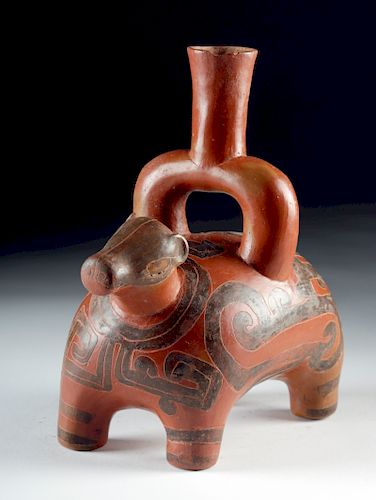Chavin Pottery Llama Stirrup Vessel
Lot 128
About Seller
Artemis Gallery
686 S Taylor Ave, Ste 106
Louisville, CO 80027
United States
Selling antiquities, ancient and ethnographic art online since 1993, Artemis Gallery specializes in Classical Antiquities (Egyptian, Greek, Roman, Near Eastern), Asian, Pre-Columbian, African / Tribal / Oceanographic art. Our extensive inventory includes pottery, stone, metal, wood, glass and textil...Read more
Estimate:
$5,000 - $7,000
Absentee vs Live bid
Two ways to bid:
- Leave a max absentee bid and the platform will bid on your behalf up to your maximum bid during the live auction.
- Bid live during the auction and your bids will be submitted real-time to the auctioneer.
Bid Increments
| Price | Bid Increment |
|---|---|
| $0 | $25 |
| $300 | $50 |
| $1,000 | $100 |
| $2,000 | $250 |
| $5,000 | $500 |
| $10,000 | $1,000 |
| $20,000 | $2,500 |
| $50,000 | $5,000 |
| $100,000 | $10,000 |
| $200,000 | $20,000 |
About Auction
By Artemis Gallery
Dec 20, 2018
Set Reminder
2018-12-20 10:00:00
2018-12-20 10:00:00
America/New_York
Bidsquare
Bidsquare : Warehouse Clear Out - Ancient & Ethnographic
https://www.bidsquare.com/auctions/artemis-gallery/warehouse-clear-out---ancient-ethnographic-3742
Time to clear out the warehouse, as these lots are going, going, gone... plus a we've added a nice selection of lots brand-new to auction! Artemis Gallery info@artemisgallery.com
Time to clear out the warehouse, as these lots are going, going, gone... plus a we've added a nice selection of lots brand-new to auction! Artemis Gallery info@artemisgallery.com
- Lot Description
**First Time At Auction**
Pre-Columbian, North Coast Peru, Chavin, Santana-Santa River, ca. 900 to 500 BCE. An incredible ceramic stirrup vessel in the form of a stylized llama or alpaca with incised harpy eagle heads and glyphs highlighted in black color on a deep red background. The body of the animal is sturdy, with the small head and tail projecting from either end. The head has cute, curved ears and long, almond-shaped eyes. The stirrup and spout are similarly sturdy and thick, pleasing to hold and with a wide, flared mouth. Size: 4.15" L x 8.9" W x 9" H (10.5 cm x 22.6 cm x 22.9 cm)
Llamas and their kin, alpacas, are the largest animals domesticated in the New World, originating from the wild guanaco. This seems to have occurred around 2000 to 1500 BCE, with the process of domestication lasting several hundred years. By the time of the Chavin, when their capital, Chavin de Huantar, influenced a massive area of Peru from the Lambayeque Valley to Ayacucho, the animals were herded and hunted as a matter of course. Dried llama meat known as ch'arki, traded from high altitude environments to the coast, was a luxury food. This vessel would have been a symbol of wealth for its owner, who was probably buried with it containing a sacred liquid offering.
Provenance: private Hawaii, USA collection; ex-private Hart collection, San Diego, California, USA
All items legal to buy/sell under U.S. Statute covering cultural patrimony Code 2600, CHAPTER 14, and are guaranteed to be as described or your money back.
A Certificate of Authenticity will accompany all winning bids.
We ship worldwide and handle all shipping in-house for your convenience.
#136615Tiny chip from rim. Repaired and restored from multiple pieces. The restoration is excellently done and almost impossible to see.Condition
- Shipping Info
-
All shipping is handled in-house for your convenience. Your invoice from Artemis Gallery will include shipping calculation instructions. If in doubt, please inquire BEFORE bidding for estimated shipping costs for individual items.
-
- Buyer's Premium



 EUR
EUR CAD
CAD AUD
AUD GBP
GBP MXN
MXN HKD
HKD CNY
CNY MYR
MYR SEK
SEK SGD
SGD CHF
CHF THB
THB
















